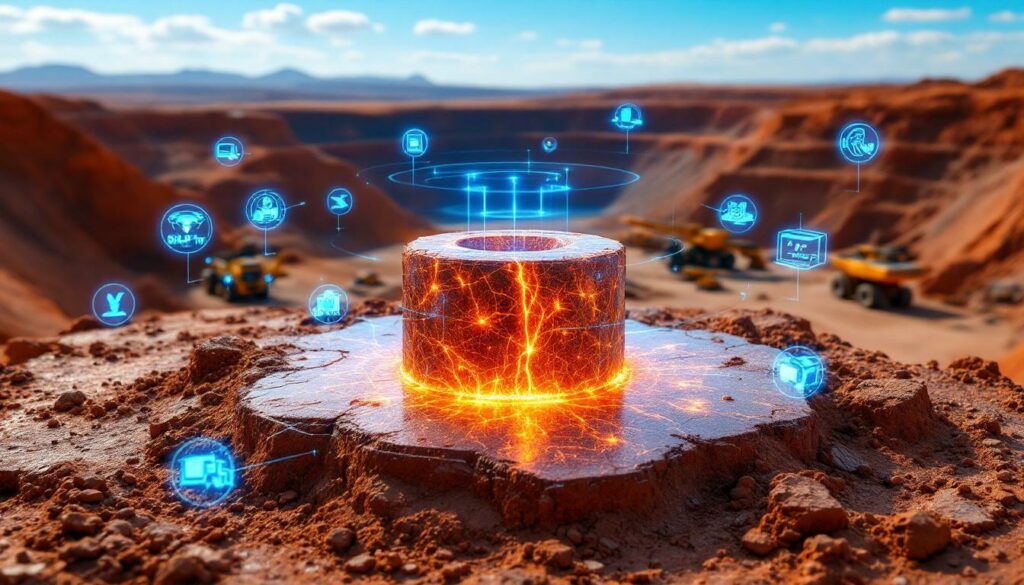How is AI Transforming Mining Exploration and Development?
Artificial intelligence is revolutionizing the mining industry through dramatic improvements in how companies discover, evaluate, and develop mineral resources. This technological revolution comes at a critical time as global demand for minerals essential to the clean energy transition surges dramatically.
Mining exploration traditionally relied on extensive field work, laboratory analysis, and expert interpretation—processes that could take months or even years. AI-powered solutions are compressing these timelines into days or weeks, while simultaneously improving accuracy and reducing costs.
Cutting-edge algorithms now process multiple data sources simultaneously, analyzing patterns invisible to human geologists. According to recent McKinsey research, AI implementation reduces drilling expenditures by 20-30% through more targeted exploration approaches.
The impact is particularly visible in critical mineral exploration, where AI in Drilling & Blasting applications have demonstrated remarkable efficiency gains:
- Pattern recognition: Neural networks analyzing historical drilling data achieve 95% accuracy in predicting likely deposit locations
- Multi-source data integration: Algorithms processing satellite imagery, geophysical surveys, and drilling results 100x faster than manual methods
- Resource modeling: AI-generated geological models reducing exploration timelines from 18 months to 6 months
The environmental benefits are equally significant. By precisely targeting drill sites, companies reduce their physical footprint, minimize waste rock generation, and lower carbon emissions associated with exploration activities.
What is GeologicAI and How Did It Secure $44 Million in Funding?
GeologicAI has emerged as a frontrunner in the mining technology revolution, developing an integrated platform that combines advanced sensor technologies with sophisticated machine learning algorithms. The company's recent funding success underscores the growing industry recognition of AI's transformative potential.
The Strategic Investment Round
In July 2025, GeologicAI completed a significant Series B funding round totaling $44 million (C$60.3 million), led by Blue Earth Capital. This strategic investment attracted participation from mining industry giants including BHP Ventures and Rio Tinto, alongside continued support from existing investors such as Breakthrough Energy.
The funding structure reflects a strategic alignment between financial investors seeking sustainability-focused technologies and industry players recognizing the competitive advantage AI brings to mineral exploration. Blue Earth Capital, known for its "electrification portfolio" strategy, views GeologicAI as a critical enabler of the clean energy transition.
GeologicAI's Technological Platform
At its core, GeologicAI's platform represents a paradigm shift in mineral exploration through its unique combination of hardware and software innovations:
"GeologicAI's sensor fusion platform eliminates weeks-long lab delays, delivering real-time lithology interpretation and mineral identification." – Dr. Evan Zhao, CTO of GeologicAI
The system integrates multiple sensing technologies:
- Hyperspectral imaging capturing the unique spectral signatures of various minerals
- X-ray fluorescence (XRF) providing elemental composition data
- 3D imaging creating precise structural models of core samples
- Laser-induced breakdown spectroscopy (LIBS) for trace element detection
This multi-sensor approach generates unprecedented data richness, which is then processed by convolutional neural networks trained on millions of validated mineral samples. The result is sub-millimeter mineral identification and characterization that far exceeds human capabilities in both speed and accuracy.
BHP's pilot implementation at the Jansen Potash Mine demonstrated the platform's effectiveness, achieving 22% faster resource modeling compared to conventional methods.
Why is AI-Driven Mining Technology Gaining Traction?
Critical Minerals Supply Challenge
The global transition to clean energy technologies has created unprecedented demand for critical minerals. According to the International Energy Agency's Net Zero Roadmap, lithium demand alone is projected to outstrip supply by 30% by 2030 without significant new discoveries and production increases.
This supply crunch is intensified by multiple converging factors:
- Exponential AI infrastructure growth: Data centers powering artificial intelligence applications require massive quantities of copper, aluminum, and rare earth elements
- Transportation electrification: Electric vehicle production demands 6x more minerals than conventional vehicles
- Energy storage expansion: Grid-scale batteries necessary for renewable integration depend on lithium, nickel, and cobalt
- Geopolitical supply concentration: Critical minerals production remains highly concentrated in a few regions, creating supply chain vulnerabilities
"Today's critical minerals are concentrated in just a few regions, making the global supply chain highly vulnerable to conflict and disruption." – Carmichael Roberts, Breakthrough Energy Ventures
This growing supply-demand gap creates urgent pressure to accelerate discovery and development of new mineral resources—precisely where AI Mining Efficiency Boost technologies demonstrate their greatest value.
Traditional Mining Limitations
Conventional mineral exploration and development processes face substantial challenges that have limited the industry's ability to respond to surging demand:
Time constraints: Traditional core analysis typically requires 4-8 weeks for processing and interpretation, creating significant bottlenecks in decision-making pipelines. AI systems reduce this to 48 hours or less.
Cost inefficiencies: Exploration drilling costs average $250 per meter using conventional targeting methods, with AI-guided approaches reducing this to approximately $180 while improving success rates.
Resource waste: Without precise targeting, exploration programs generate excessive waste rock and environmental disturbance, increasing both environmental impact and regulatory scrutiny.
Skilled labor shortages: The mining industry faces a growing shortage of experienced geologists capable of interpreting complex geological data, while AI systems can leverage the expertise of a few specialists across many projects.
These limitations have made the industry ripe for technological disruption, with AI-driven solutions addressing multiple pain points simultaneously.
How Does GeologicAI's Technology Transform Mining Operations?
Real-Time Core Analysis
The platform's ability to scan and analyze drill core samples in real-time represents a fundamental shift from traditional methods. While conventional approaches require shipping samples to laboratories, waiting weeks for results, and then manual interpretation by geologists, GeologicAI's system delivers comprehensive analysis within hours of core extraction.
This dramatic compression of the analysis timeline transforms exploration workflows:
- Immediate decision-making: Drilling programs can be adjusted based on same-day results
- Continuous operation: No waiting periods between drilling phases
- Reduced logistics complexity: Minimized sample transportation and handling
The system's 0.5mm resolution scanning detects trace minerals invisible to human eyes, identifying economic opportunities that might otherwise be missed. At 500 data points processed per second, the platform generates orders of magnitude more information than manual methods.
Enhanced Decision Intelligence
By combining multiple sensor inputs with machine learning algorithms, GeologicAI delivers unprecedented geological insights that dramatically improve decision-making capabilities:
More accurate geological models: AI integration of multiple data streams creates three-dimensional representations with higher fidelity than traditional methods.
Higher resolution data visualization: The platform's ability to detect subtle mineralogical variations enables more precise ore body delineation.
"Machine learning models reduce 'ore loss' by 18% through boundary delineation algorithms that identify economic mineralization zones conventional methods might miss." – Dr. Anika Patel, BHP Principal Geologist
Improved predictive capabilities: Pattern recognition algorithms identify geological trends that suggest additional mineralization beyond current drill areas.
Faster decision-making processes: Real-time data availability means exploration and development decisions no longer wait for laboratory results.
Reduced uncertainty: Statistical confidence levels in resource estimates improve significantly through comprehensive data collection and consistent analysis methodologies.
Environmental Impact Reduction
The technology potentially reduces mining's environmental footprint through several mechanisms:
- More precise targeting of viable deposits reduces the number of drill sites required
- Optimized drill hole placement minimizes surface disturbance
- Earlier identification of waste rock enables better waste management planning
- Reduced water and energy consumption through more efficient exploration programs
Newmont's implementation at the Tanami mine demonstrated a 30% reduction in exploratory drilling waste through AI-guided targeting. The environmental benefits extend beyond the exploration phase, as improved ore body knowledge enables more selective mining with less waste production during operations.
What Will the $44 Million Investment Enable?
Global Expansion Strategy
The newly secured funding will accelerate GeologicAI's expansion into key mining regions worldwide. Currently operational across five continents, the company plans to significantly strengthen its presence in areas critical to mineral supply chains:
- Chile: Expanding lithium exploration capabilities in the Atacama region
- Zambia: Enhancing copper discovery programs in the Copperbelt
- Canada: Developing nickel exploration services in Ontario and Quebec
- Australia: Strengthening rare earth elements exploration capabilities
This geographic expansion strategy targets regions with both established mining operations and under-explored potential, positioning GeologicAI to support both brownfield optimization and greenfield discoveries.
Technology Development Acceleration
A significant portion of the investment will fund continued advancement of the platform's capabilities:
Proprietary AI algorithms: Further refinement of the machine learning models through additional training data and improved neural network architectures.
Sensor technology enhancements: Development of next-generation sensing capabilities, including the "quantum lithography" project for atomic-scale mineral mapping.
Data integration capabilities: Enhanced ability to incorporate external data sources such as satellite imagery, geophysical surveys, and historical drilling information.
Machine learning model refinement: Implementation of reinforcement learning approaches for adaptive ore body modeling in complex geological settings.
Industry Integration Initiatives
The backing from major mining companies suggests potential for deeper integration of GeologicAI's technology into established mining operations:
Standardization efforts: Working with industry bodies to establish AI-based geological analysis standards.
Collaborative development: Partnerships with mining companies to customize solutions for specific mineral targets.
Implementation across diverse environments: Adaptation of the platform for challenging settings including deep underground mines, remote locations, and extreme climates.
These integration initiatives will be critical for widespread adoption, as mining technology investments typically approach new technologies cautiously, requiring demonstrated value before full-scale implementation.
What Do Industry Leaders Say About GeologicAI's Potential?
Blue Earth Capital's Perspective
Kayode Akinola, head of Private Equity at Blue Earth Capital, emphasized the critical role of mineral supply in the energy transition:
"A significant increase in the supply of critical minerals is essential for the energy transition and specifically electrification, and we believe GeologicAI is at the forefront of providing solutions to improve the recovery process while reducing the environmental footprint."
This investment aligns with Blue Earth Capital's focus on technologies that address sustainability challenges while delivering competitive financial returns.
BHP's Strategic View
Laurel Buckner, Vice President of Ventures at BHP, highlighted the transformative potential:
"GeologicAI is addressing one of the mining sector's most pressing challenges. Their game-changing technology is disrupting traditional, time- and cost-intensive workflows with AI-powered analytics and modelling solutions. This technology has the power to reshape how we discover, evaluate and source ore bodies."
BHP's 12-month trial of the technology showed 25% higher confidence intervals in resource estimates, validating the platform's effectiveness in real-world mining environments.
Breakthrough Energy's Assessment
Carmichael Roberts from Breakthrough Energy Ventures pointed to supply chain resilience:
"Today's critical minerals are concentrated in just a few regions, making the global supply chain highly vulnerable to conflict and disruption. GeologicAI's AI-driven process is accelerating the discovery and development of new deposits, strengthening the mineral pipeline that is essential for electrification."
This perspective reflects growing recognition that mineral supply security is critical to clean energy transition goals, with AI-enabled discovery representing a key enabler of diversified supply.
What Are the Broader Implications for the Mining Industry?
Democratization of Advanced Mining Technology
As AI-driven solutions become more widely available, smaller mining operations may gain access to capabilities previously limited to major corporations:
Technology accessibility: Cloud-based AI platforms reduce capital requirements for advanced geological analysis.
Expertise leverage: Junior miners can access sophisticated algorithms trained by industry experts without maintaining large technical teams.
Competitive leveling: According to S&P Global research, junior miners using AI tools now achieve discovery rates within 15% of major companies, narrowing the historical advantage of larger players.
This democratization could fundamentally reshape industry dynamics, enabling smaller players to compete more effectively for capital and opportunities. Saskatchewan uranium juniors demonstrate this potential, with shared AI platforms cutting exploration costs by 60% while improving discovery rates.
Skill Set Evolution Requirements
The integration of AI technologies is driving significant changes in mining workforce requirements:
- Data science expertise: 65% of geologists now require data science training according to the ICMM Workforce Report
- Hybrid professionals: Growing demand for "geo-data scientists" combining geological knowledge with computational skills
- Algorithm management: New roles focused on supervising and validating AI-generated insights
- Digital modeling specialists: Increased need for professionals who can interpret AI-generated geological models
This evolution creates both challenges and opportunities. While traditional geological skills remain valuable, they increasingly must be complemented by digital capabilities. Mining companies and educational institutions are responding with specialized training programs that bridge these disciplines.
Supply Chain Resilience Enhancement
By accelerating discovery and development of new mineral deposits globally, technologies like GeologicAI's platform could help diversify supply sources for critical minerals:
Geographic diversification: AI-enabled exploration makes previously overlooked regions economically viable for exploration.
Secondary resource identification: Advanced analysis identifies valuable minerals in waste streams and tailings.
Development timeline compression: Faster resource characterization reduces the time from discovery to production.
Dr. Hiro Tanaka of the World Economic Forum notes that "AI commoditization could redistribute $2 billion in exploration value to mid-tier producers," potentially creating a more diversified supplier ecosystem less vulnerable to geopolitical disruptions.
How Does This Development Compare to Other Mining Technology Advancements?
AI Integration vs. Autonomous Equipment
While autonomous mining equipment has received significant attention in recent years, AI-driven geological analysis represents a different approach to efficiency gains:
| Technology Area | Investment (2024) | Typical ROI Timeframe | Primary Value Driver |
|---|---|---|---|
| Autonomous Haulage | $1.2 billion | 3-5 years | Operational cost reduction |
| AI Geology | $380 million | 12-18 months | Resource discovery/valuation |
| Remote Operations | $850 million | 2-3 years | Workforce efficiency |
| Predictive Maintenance | $560 million | 18-24 months | Equipment availability |
According to McKinsey's analysis, AI exploration delivers 5x faster payback than automation technologies, though with different risk profiles. While autonomous systems offer predictable operational savings, AI exploration can potentially deliver exponentially higher returns through new discoveries, albeit with greater uncertainty.
Complementary Technology Ecosystem
GeologicAI's approach appears designed to complement other industry innovation trends:
Drone integration: AI analysis enhances value from drone-collected data by extracting deeper insights.
Satellite imagery analysis: Machine learning algorithms combining satellite data with ground-based sensing improve targeting accuracy.
Digital twin modeling: GeologicAI outputs feed directly into comprehensive digital mine models like Hexagon's HxDR platform.
Predictive maintenance systems: Geological insights inform equipment deployment strategies and maintenance scheduling.
This complementary relationship creates potential for compound benefits when multiple technologies are deployed together. Eritrean copper surveys demonstrated that AI analysis added 35% more value to drone-collected data compared to conventional interpretation methods.
Investment Trend Significance
The substantial funding secured by GeologicAI indicates growing investor confidence in AI applications for resource industries:
- Venture capital shift: Resource technology attracting increased attention from technology investors
- Strategic corporate investment: Major miners taking direct stakes in AI startups
- ESG alignment: AI exploration positioned as both financially and environmentally advantageous
This investment trend suggests a broader recognition that mining's digital transformation will be capital-intensive but potentially transformative for industry economics. The integration of sustainable mining transformation and financial outcomes in these investments represents an important evolution in mining technology funding.
What Challenges Might GeologicAI Face in Implementation?
Integration with Existing Systems
Mining companies typically operate with established workflows and legacy systems, creating potential challenges for new technology adoption:
Data architecture limitations: 70% of mines use pre-2010 data architectures according to Accenture's Mining Survey, creating compatibility challenges.
Workflow disruption: Implementation requires changes to established exploration and resource modeling processes.
Organizational resistance: Cultural barriers to AI adoption in traditionally conservative organizations.
Technical expertise gaps: Limited in-house capabilities to support advanced AI technologies.
Successful implementation will require thoughtful change management strategies, including phased approaches that demonstrate value while minimizing disruption to ongoing operations.
Data Quality and Standardization
The effectiveness of AI systems depends heavily on data quality, consistency, and standardization:
- Historical data limitations: Only 45% of historical drill logs meet AI-ready standards according to AMIRA International
- Inconsistent logging practices: Variable terminology and classification schemes across different mining operations
- Validation challenges: Establishing ground truth for training AI models
Ready to Catch the Next Major Mineral Discovery?
Stay ahead of the market with Discovery Alert's proprietary Discovery IQ model, providing instant notifications when significant ASX mineral discoveries are announced. Explore our dedicated discoveries page to understand how major mineral discoveries have historically led to exceptional market returns, and start your 30-day free trial today.




